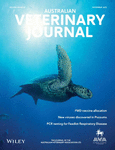Many of you will already know that AMRRIC have been actively involved in various facets of the canine ehrlichiosis outbreak in Australia. This has included the development of communication resources for remote Indigenous communities and for local governments and sharing information at various events and through our education programs. Dr Bonny Cumming (Program Manager, Strategic Delivery) and Dr Chelsea Smart (Program Manager, Operational Delivery) have also been involved in a research study, led by the University of Adelaide, on the distribution and spread of the bacteria, E. canis, which causes ehrlichiosis. The study has recently been published in the Australian Veterinary Journal, which we are pleased to share here.
E. canis is spread by a vector, the tropical brown dog tick. As dogs are moved around, so too are the infected ticks, infected ticks then transmit the disease to other dogs. In the study, the research team examined museum specimens of the brown dog tick, as well as samples of brown dog ticks from seven remote Indigenous communities in South Australia. They then used polymerase chain reaction (PCR) testing to detect E.canis in the ticks. When the study commenced in November-December 2020, the percentage of dogs hosting PCR-positive ticks was 2.8%. By February 2021, the proportion of dogs hosting PCR-positive ticks had increased to 62.9%.
These results suggest that E.canis spread rapidly, and worryingly, the brown dog tick is more widespread in South Australia than previously thought. A range of factors are likely to contribute to the spread of E. canis, particularly in a remote community context: the free-roaming nature of dogs; dogs being moved around with people; the limited availability of environmental health services (and associated poor control of ectoparasites like ticks) and favourable climatic conditions for tick reproduction.
The implications of the rapid spread across SA of E. canis for dogs is not well understood. Unfortunately, very remote areas such as the Anangu Pitjantjatjara Yankunytjatjara (APY) Lands have extremely limited access to veterinary services, so dogs which develop ehrlichosisis are likely to go untreated.
Research papers such as this one are an important part of disseminating new knowledge amongst veterinarians and animal health workers. The paper highlights the strong need for effective detection and control programs for the disease, and the need for additional One Health research to improve the understanding the disease and its impacts in Australia. AMRRIC is pleased to be able to contribute to building the scientific evidence base for our work, and thanks the co-authors and communities involved in the development of this paper.
